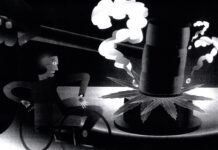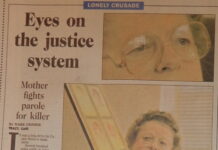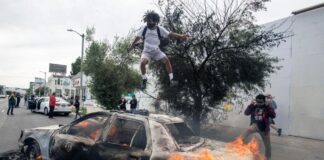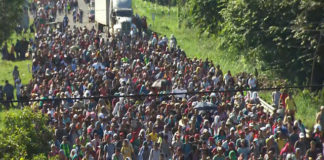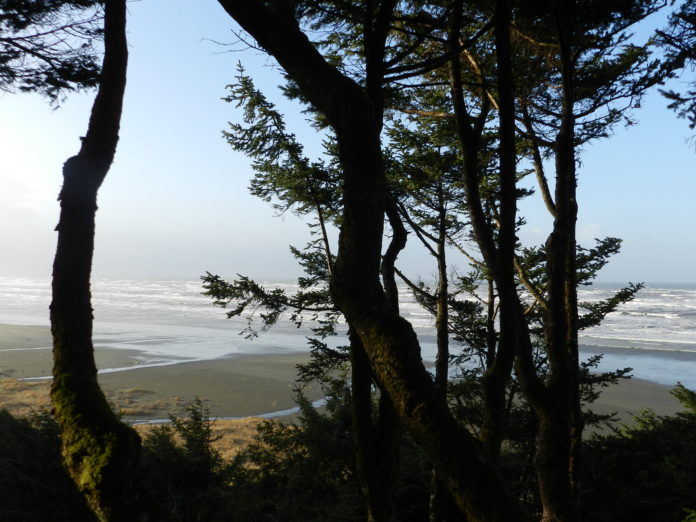
A reflection amid the cold bloom of a fine winter as the watershed year of 2016 slips away
By Mark Cromer
Standing alongside the Bengal tiger habitat at the Cougar Mountain Zoo in Issaquah, I marvel at the sheer size of the tigers and their graceful, powerful poise, while simultaneously trying to navigate the rushing tide of guilt that is washing over me as I watch one of the magnificent great cats pace helplessly inside a drained pool.
Having paid my general admission, I feel like an accomplice-after-the-fact to a crime against nature.
These tigers should be roaming the wilds of Asia, not penned and put up on display here in Northern Washington, but then again they’ve been poached and human encroached to the brink of extinction in their native habitat and zoo exhibits around the globe offer people a chance to put a real creature into perspective and hopefully better inform them of the ecologically relevant decisions they make.
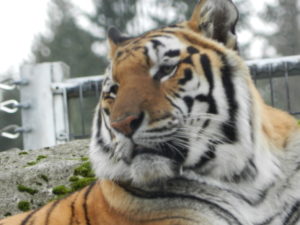
And the votes they cast. And the appetites they indulge.
As I ponder that negotiated compromise of my own set of principles a woman standing next me remarks “I feel bad for them when they pace, I think it means they’re nervous. And where can they go?” I tell her I was just thinking something along the same lines, but before I could elaborate she suddenly interjects “Of course after these past couple of months, I can relate. I’m nervous too, after my country made such a terribly stupid decision.”
The comment prompts me to look at her for a moment.
She’s a white woman in her late 30s or maybe her early 40s, of the fairly well-kept house frau with hints of granola variety, the kind of Subaru Crossover-driving mom that are now far more ubiquitous on Cougar Mountain than pumas ever were. I hadn’t considered that the local zoo might seem like an appropriate place to start an impromptu episode of CNN’s Crossfire with the stranger beside you, but then I suspected she was probably anticipating some nodding echo of ‘I know, right?’ to validate not so much her political grief as her casual righteous indignation over Election 2016 that continues to radiate ever brighter in many quarters as January 20, 2017, draws closer.
“You’re an American, right?” I ask.
“I thought I was,” she says. “But increasingly I wonder.”
“Yeah,” I say, looking back at the tigers. “Well, I tell ya sister, I for one feel quite proud of our country of late, seems like we’re getting back on the right track. It’s all rather invigorating.”
She doesn’t say a word but stands there for a moment silently staring at the side of my gray-bearded mug until I look at her again, just in time to see her nostrils flared and her upper-lip curled neatly into a corner transmitting the internationally recognized signal of disgust before she tromps off toward the equally depressing North American Gray Wolf habitat.
“Nice talking with you,” I laugh. “And Merry Christmas!”
As I make my way back to the Jeep the sweetly seditious lyrics of Simon & Garfunkel come to me… “Someone told me it’s all happening at the zoo…I do believe it, I do believe it’s true…” and I find myself singing that American tune softy to myself all the way back over to the Rolling Log Tavern for a fresh vodka and lime and some quiet time to myself.
On a cliff above the wild coastline of Washington’s Olympic Peninsula it’s a weekday morning and I am the lone patron in the dining room at the Ocean Crest Resort, a fairly high-end joint nestled along the scenic two-lane blacktop of Washington State Route 109 in Moclips, a familiar and reassuringly pleasant speck of humanity that numbers no more than several hundred people.
I’m waiting on some French toast and nursing a coffee over a hangover while I pour through The New York Times, the pages of which remind me how little has changed since that seminal year of 1980, back when I was a working class white kid at Pomona High School and the headlines were screaming Carter, Reagan, Russians, Iran, Israel, Palestine and dead legendary rockers.
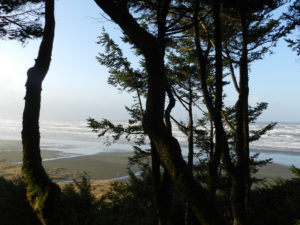
My table sits aside the stretch of windows that afford a sweeping view of the lush flora that blankets the collapse of the hillside to the open shoreline below and I’m struck by how little has changed here too since God knows when, as the sand beyond gives way to the churning breakers that ceaselessly charge the beach, rolling swells frothing white that just keep coming. And so it shall ever be, at least I’d like to think.
But some things have changed up here.
Just a stone throw south a developer’s melanoma dubbed ‘Seabrook’ has manifested and spread, with gingerbread homes and a New England faux town square appearing with all of the honest soul of a Disney-inspired theme park after the developers clear-cut their way through stands of pines to make way for stacked homes that provide such a Seahaven-style of living from The Truman Show that even Martha Stewart gushed on her website: “Backyards are virtually nonexistent, nudging people to gather on front porches; homes are close together, and shared services, like fire pits and an indoor swimming pool, abound…The stunning rain forests and beaches of Olympic National Park are a short and scenic drive north.”
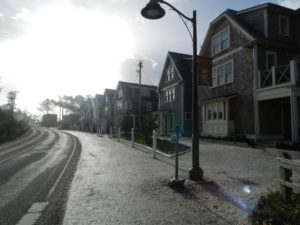
Ostensibly in development at least since 2004, the Imagineers of Seabrook have bulldozed their Fantasyland into existence on the Olympic coast in a remarkably short time, since most of it wasn’t there the last time I drove up Highway 109 not long ago. So rounding a curve to suddenly find a clear-cut that has sprouted InstaHomes poured into a Thomas Kinkade mold and missing only their sugar-glazed roofs and candy cane gates was a gut-punch punctuated by the sign offering the perverse suggestion to ‘Shop-Dine-Stay’ that just made me want to ‘Drive-Cry-Puke.’
Of course, as I pour maple syrup over my French toast and relish the fact that I’m the only guest at the Ocean Crest this morning savoring a five-star view of the north coast, I accept the relative hypocrisy of my reaction to the obscenity of Seabrook. I recognize this place that I love being at also came at a cost of trees, coastline and habitat to native species that were here first. Thus here too in destruction lay the joy of creation. So why do I want to unfold the beautiful inky broadsheet of New York’s Old Gray Lady of print journalism at my breakfast table and smugly look down my long and conveniently-crooked preservationist nose at the private equity group that is building their version of their own dream down the road for generations yet to come?
But it’s only an ephemeral thought.
One that reminds me of my fleeting moments of introspection every time a car pulls up next to mine blasting gangsta rap or speed metal and I wonder whether it’s fair to judge that thumping or screaming sludge against the art of James Brown or Black Sabbath? And then I realize, yes, it is fair to judge it as such, and the Godfather of Soul and the Sabs were indeed better in so many ways and on so many levels that I need not ponder it any further. It’s just a fact.
So as I devour my French toast and sink back into the newspaper—another semi-relic that I still find superior in the tradecraft of journalism, with the tactile experience a bonus—I allow myself the indulgence of affording Ocean Crest and the other older joints that planted themselves along the coastline a generation or more ago the respect they deserve for the simple reason that they are better. In substance, in engagement and in purpose the old school joints reflect a better ideal.
If holding that ground plants me in my own personal Alamo like some obstinate generational dead-ender railing against new growth and sounding like Archie Bunker meets George Jefferson meets Fred Sanford at a Sunday morning meeting of Citizens Against More People Except Us, well, at least I’m in good company. And spatially speaking, the old joints were outposts planted on the edge of heaven, not the garish land rush unfolding across Northern Washington that Seabrook’s slam-jam represents.
But if Seabrook is the ‘God help us all!’ of what’s on our American horizon, then Aberdeen is the ‘Good Lord what happened?’ in our nation’s rearview mirror, a desolate harbor town about a half hour south of Moclips that would be unknown still were it not for Kurt Cobain.
Thus the sign welcoming you into town reads “Come As You Are.” Sounds good. But you don’t have to walk around long once you’ve come as you are—or actually even get out of the car—to realize the sign on the way out of town should read “Please Send Help!”
Aberdeen: The white micro-Detroit of the Pacific Northwest.
Each time I’ve driven through it, gazing upon the rows of boarded up homes, shuttered motels and dead businesses that dotted throughout the town with the busted down mom n’ pops and the last chance taverns gasping but still alive, I am reminded of my grim drive through the Motor City in the summer of 1985 or virtually any time I find myself in San Bernardino.
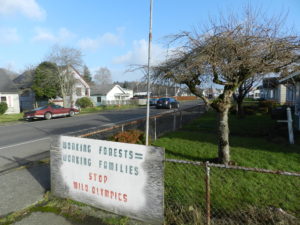
Aberdeen is a city that seems to have died and yet is somehow still not quite dead, a municipal zombie whose gray pallor and gritty streets speak highly of heroin, just sans the Manhattan sleek chic, and it stumbles along looking for the jobs that the mills once provided it. Logging trucks still lumber down Route 109 but to where I’m not sure, other than where they go it certainly no longer seems to be anywhere that matters much in Aberdeen, though along all too brief stretches of still quaint streets handmade signs hang on front yard fences that read ‘Working Forests = Working Families’ but I doubt Olympia or the other Washington in the American Far East is listening.
Like Detroit, Aberdeen is an American heartbreak, an American betrayal.
Yet one more American town left behind without so much as a ‘We Regret To Inform You’ letter from the suits inside the Beltway advising them that their sweat equity over a century has evaporated into the fantasy flavored vape hit of ‘job training seminars’ that will better prepare the survivors for a reconfigured global economy.
But in the meantime, they should probably up their daily opioid dosage.
My French toast finished and my coffee topped off with my last refill, I ask for the check and as I wait for it I make up my mind to drive at least a little further north, to the Hi-Tide, and walk along the Moclips River Estuary once more, down to the shoreline, and consider the State of the Nation further from there. The airline-size micro-bottles of New Amsterdam vodka I happen to have with me should help as I sort it all out.
As I walk along the estuary toward the ocean I am again reminded of my solitude here amid a wind that snaps off the water and rushes across a smooth lunar shoreline, stirring the sand and then sending it snaking in whispering streams inland.
I am the only person in sight and this is comforting.
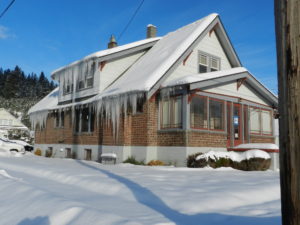
The week before I had driven back to Cle Elum in the Cascades and it was a road trip that proved to be a purely white-knuckled affair on a snowbound I-90 that took about three times longer than usual, slogging behind snowplows and spinouts and I arrived in that small mountain town that was blanketed in fresh powder just to walk around for a spell and have a couple short ones with the locals at The Caboose before splitting back to Issaquah and while it was cold up there, I didn’t really shiver much. And it wasn’t entirely thanks to the Russian anti-freeze.
But now out here on the vast shoreline in Moclips, a place completely absent of snow and with skies rapidly changing from gray to crystal blue and then back to a deep charcoal and with me nonetheless thoroughly bundled up under thermal layers encased by a Nautica slicker, I find the wind coming off the Pacific is a brutally cold dagger that pierces me to my old bones, sharp stabs that leave me plodding as my feet sink into the sand. I figure it’s Mother Earth’s way of whispering into our human ears a bittersweet reminder of our fragility and her authority.
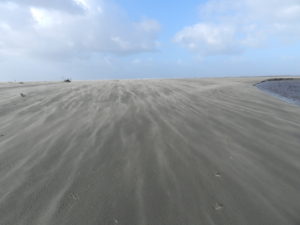
I drink in the deep sweep of the ocean in front of me, from its hiss racing across the shore to the silence of the far horizon it reaches to and I think of the year that has come and gone and I find a familiar song bubbling forth into my consciousness.
“Spinning on that dizzy edge
I kissed her face and kissed her head
And dreamed of all the different ways I had
To make her glow…”
Standing on the wild shoreline of Moclips humming The Cure’s Just Like Heaven to myself doesn’t seem like a particularly bad way to usher out the year on the tail of another long December.
On the way back to my Jeep I decide to detour over the sand dunes to the beachfront place from that summer before and look for something. There are painted rocks scattered all over the place, small hand-painted monuments left by the people who have found themselves here getting lost for awhile and there are hundreds of them below the row of balconies of the Hi-Tide’s beach pads that perch just in front of the dunes.
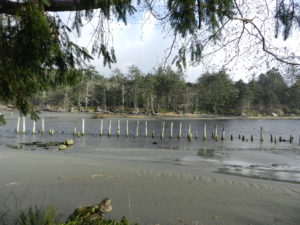
I take my time but I don’t see it. I’m surprised as I can’t imagine that many people have been here since we were last summer, and I seem to remember we left it on the driftwood log that had been dragged up here, but there’s a collection of more recently painted rocks on there now. I’m momentarily bummed but so it goes. I start walking back to the Jeep but then turn around and walk back over for a last look around where I was certain it should have been. I know if I don’t give it a last once-over it will bug me later. And then I notice there’s a tip of a painted rock just sprouting out of the mulched ground cover that’s spread under the balconies. I sweep my foot over it and uncover some other lovers painted ‘We Were Here’ rocks from a couple years ago and I realize there must be more buried here.
Two more sweeps of my foot and suddenly—there it is.
Our rock. The one she painted bright with our names that lazy late summer day, still here after all. Now I feel somehow content and I laugh out loud thinking how it didn’t matter so much until it seemed that it wasn’t there. Ah, but it was.
An old mile-marker of my life; battered and buried, but still here.
This calls for a drink.
I head back to the Jeep and then on to someplace warmer and out of the wind where I can consider it properly, and I can still hear The Cure.
“Daylight licked me into shape
I must have been asleep for days
And moving lips to breathe her name
I opened up my eyes…”
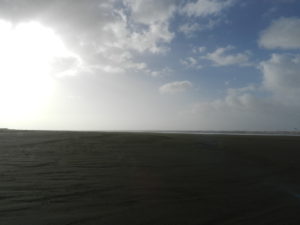
It’s an early afternoon and I’m on the back patio of the Last Frontier Saloon in Fall City. When I walked in I found Christina behind the bar and yet another refreshing reminder of why this small outpost remains a destination of choice for me: her free-hand long pour with a smile that says ‘Welcome back.’
The year of 2016 is in its final days and as I light a smoke and consider it the only other cat out in the cold for a cigarette break with his whiskey remarks almost haphazardly “Doesn’t look like a bad day at all.”
I look up at the sky for a moment and then offer “No, it really doesn’t.”
We start talking casually about the weather and I mention the passing of the Winter Solstice how the days are slowly getting longer now if still colder and he seems suddenly oddly scientific in his knowledge of sunrises and sunsets, the Earth’s position in its relationship to the sun and what this seasonal weather means in terms of natural lighting.
“You seem, um, rather specific about this, and yet I’m not sure I’d peg you for a meteorologist,” I say. “What do you do for a living?”
“I’m a photographer, a professional photographer. So it became my business a long time ago to know everything I could about the seasons and what that likely means for natural lighting,” he says. “I know, it sounds freakish.”
“Actually, it sounds refreshing,” I say.
“What do you do for a living?” he asks.
“Well, I was a journalist, a professional journalist,” I say, parroting his riff. “Then as the newspapers cratered, I made my way into business intelligence and investigations. So it became my business to basically pay attention, write it down and hopefully make sense of it later.”
We share a laugh and over refreshed drinks and more smokes we kill the next hour talking old shop. The same age roughly by a year, we quickly reveal and revel in our mutual disgust for what passes as professional journalism these days, riffing on not so much an elitist jag (well, ok, maybe it was) as a sad amazement at the rise of the legion of ‘citizen journalists’ taking pictures with their phones or burping 140-characters 27 times a day and calling it journalism. Or having it labeled as such.
“We studied our craft for fucking years at the university,” he says. “Then we went out in the field and learned it all over again. And now I see these fucking kids taking pictures with their phones and posting it on Facebook and calling it journalism. Just because you have Twitter followers or an Instagram account does not a fucking journalist make you!”
I inform the good reverend he’s preaching to a fellow professional traveler but I’m still all ears and that I had been reflecting on and writing about the loss of so much of our trade for some time now, yet was still hopeful that some major publications are still carrying the torch in print.
He tells me he worked his way up the photo-journo food chain as a shooter in the 1990s to eventually land some assignments from National Geographic. He says he’s done combat work and was embedded early in Iraq. I tell him I came out of the suburban dailies around Los Angeles around the same time and made my bones as a staff writer on the crime beat before I worked my way into freelancing for the LA Weekly and the Los Angeles Times among a few other publications. We commiserate over seeing things that can’t be unseen, like other people’s brains scattered outside of their skulls, whether on the streets of Fallujah or Fontana, and of the ways journalists once and sometimes still do capture what happened beyond the limitations of vanishing space and attention spans.
It’s a proper if impromptu vent session that eventually spends itself out.
“So what the hell are you doing up here in Fall City anyway?” he asks me.
“Well, now that is a long story, but it all started for a girl…” my words trailing off with a shrug.
“As most stories worth telling usually do,” he says and we raise our glasses a last time with a knowing laugh. “To love and war.”
We say our farewells and I make my way back to the Jeep parked alongside the old Masonic Lodge and head down Preston-Fall City Road, taking the slow ride back into Issaquah, marveling at the cosmic connective tissue that seems to make this burning world even smaller as it crumbles into a million glowing embers.
Later in the evening I slip into my box seat at the Village Theatre for a performance of its production of Singing In The Rain. And as the house lights go dark I figure that singing in the rain up here just seems to hit the right note to take the year out on.



